How to Grow Mandarins: Essential Tips for Lush Citrus Trees
- March 1, 2024
- 0 comment
Mandarins, with their sweet flavor and easy-to-peel skin, are a favorite citrus fruit for many. Growing mandarins can be a rewarding experience for both novice and experienced gardeners. This guide will walk you through the basics of cultivating mandarin trees, from selection to harvest.
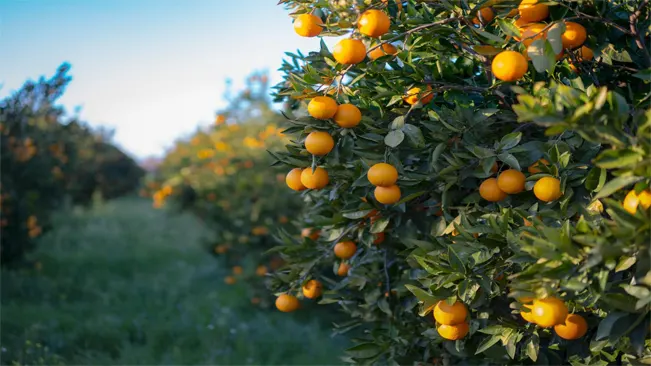
Nutritional Benefits of Mandarins
| Benefit | Description |
|---|---|
| Rich in Vitamins | Mandarins are high in Vitamin C, which is crucial for immune function and skin health. |
| Antioxidant Properties | They contain antioxidants like Vitamin A, beta-carotene, and hesperidin, which combat free radicals and support overall health. |
| Dietary Fiber | Mandarins are a good source of dietary fiber, aiding in digestion and promoting gut health. |
| Low in Calories | They are low in calories, making them an excellent snack for weight management. |
| Heart Health | The flavonoids and fiber in mandarins can help maintain a healthy heart by reducing cholesterol levels. |
| Skin Health | The high Vitamin C content helps in collagen synthesis, which is important for skin elasticity and health. |
| Blood Sugar Regulation | The fiber in mandarins can help regulate blood sugar levels, making them a good fruit choice for diabetics. |
| Cancer Prevention | Some studies suggest that compounds in mandarins may have anti-cancer properties. |
| Stress Relief | Vitamin C in mandarins can reduce stress and have a calming effect on the body. |
| Eye Health | Beta-carotene, a type of Vitamin A in mandarins, is beneficial for maintaining good vision. |
List on How To Grow Mandarins
- Choosing the Right Variety
- Climate and Location
- Soil Preparation
- Planting
- Watering
- Fertilizing
- Pruning
- Harvesting
- Pest and Disease Management
Choosing the Right Variety
There are several varieties of mandarins, including Clementine, Satsuma, and Tangerine. Each variety has its own unique flavor and growth requirements. Research and choose a variety that suits your climate and taste preferences.
Clementine

- Flavor and Characteristics: Clementines are known for their sweet taste and easy-to-peel skin. They are typically seedless, making them a favorite, especially among children.
- Growth Requirements: They prefer a warmer climate and are more cold-sensitive than some other varieties. Clementines require plenty of sunlight and well-draining soil.
- Best Suited For: Ideal for areas with mild to warm climates. They are also well-suited for container gardening due to their moderate size.
Satsuma
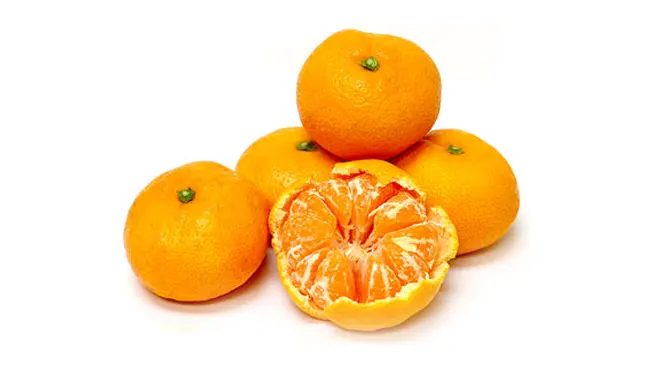
- Flavor and Characteristics: Satsumas are prized for their incredibly sweet flavor and soft, thin skin. They are generally seedless and very juicy.
- Growth Requirements: This variety is more cold-tolerant compared to other mandarins, making it suitable for slightly cooler regions. Like other citrus, they need well-draining soil and full sun.
- Best Suited For: Perfect for cooler areas within the citrus growing range. They are also a great choice for beginners due to their hardiness.
Tangerine
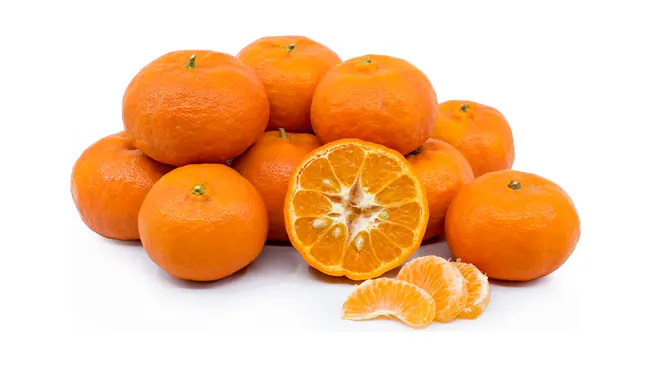
- Flavor and Characteristics: Tangerines have a stronger, tangier taste compared to Clementines and Satsumas. They usually have a thicker skin and can contain seeds.
- Growth Requirements: Tangerines are adaptable to various climates but prefer a warm environment. They need full sun and well-draining soil.
- Best Suited For: These are suitable for areas with a warm climate and are perfect for those who prefer a tangier citrus flavor.
Climate and Location
Mandarins thrive in warm, sunny climates. They are best suited to USDA zones 9-11. Choose a location in your garden that receives at least 6-8 hours of sunlight daily and is protected from strong winds.
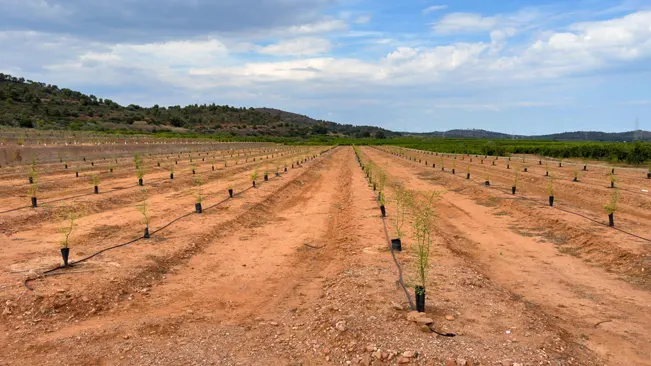
Climate Suitability
- Warmth and Sunlight: Mandarins flourish in warm, temperate climates. They need ample sunlight, at least 6-8 hours per day, to produce healthy foliage and abundant fruit. The warmth provided by the sun is also essential for the development of sweet-flavored fruits.
- USDA Zones: These trees are most suited to USDA zones 9-11. In these zones, the temperatures rarely drop to levels that could damage the trees. Mandarins are not frost-tolerant, so if you live in an area with colder winters, you may need to take protective measures or consider growing the trees in containers that can be moved indoors.
- Temperature Range: Ideally, mandarin trees prefer temperatures between 55°F and 85°F (13°C – 29°C). They can tolerate short periods of higher or lower temperatures, but prolonged exposure to extremes can be harmful.
Location Considerations
- Sunlight Exposure: When selecting a location in your garden, look for an area that receives direct sunlight for the majority of the day. This is particularly important for fruit ripening and overall health of the tree.
- Wind Protection: While mandarins need sunlight, they also require protection from strong winds. Windy conditions can damage the branches, disrupt pollination, and cause fruit to fall prematurely. A sheltered spot, perhaps near a fence or a wall, can provide the necessary protection.
- Soil Drainage: The chosen location should have well-draining soil. Poor drainage can lead to root rot, which is detrimental to the tree. If your soil is heavy or clay-like, consider raising the planting area or using raised beds to improve drainage.
Soil Preparation
Mandarins prefer well-draining soil with a slightly acidic to neutral pH. Amend heavy clay or sandy soils with organic matter to improve fertility and water retention.

Understanding Soil Needs for Mandarins
- Mandarins thrive in soil that drains well yet retains enough moisture to keep the roots hydrated. This balance is key to preventing issues like root rot, which can occur in overly wet conditions, and water stress in extremely dry conditions.
- The ideal pH for mandarin soil is slightly acidic to neutral, typically ranging from 6.0 to 7.5. Soil pH affects nutrient availability, with mandarins preferring this range for optimal growth.
Improving Soil Quality
- For heavy clay soils, which tend to retain water and restrict root growth, incorporating organic matter like compost or well-rotted manure can improve drainage and aeration. This amendment helps create a looser soil structure, allowing roots to expand more easily and water to drain more efficiently.
- In sandy soils, which drain quickly and may struggle to retain nutrients and moisture, adding organic matter also helps. It increases the soil’s ability to hold water and nutrients, making them more available to the tree roots.
- The use of organic mulch around the base of the tree can further help in maintaining soil moisture and temperature, as well as adding organic matter to the soil as it decomposes.
Testing and Adjusting Soil pH
- Before planting, it’s advisable to test the soil pH. If the pH is too high (alkaline) or too low (very acidic), it can be adjusted.
- To lower the pH of alkaline soils, sulfur or peat moss can be added. To raise the pH of overly acidic soils, lime is commonly used.
- It’s important to adjust the pH gradually and retest the soil over time to avoid sudden changes that might stress the plant.
Long-term Soil Health
- Regularly adding organic matter and ensuring balanced fertilization will maintain the soil quality over time. Avoid over-fertilizing, as this can lead to salt buildup in the soil, which can harm the roots.
- Periodic checks and adjustments to the soil composition and pH will help in ensuring that the mandarins continue to grow in an optimal environment.
Planting
The best time to plant mandarin trees is in the spring or fall. If you’re planting a grafted tree, ensure the graft union is above the soil line. Water the tree deeply after planting to settle the soil.
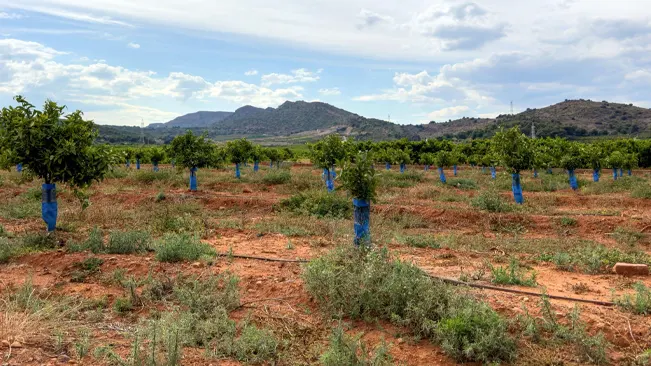
Choosing the Planting Time
- Spring and fall are ideal for planting mandarin trees. These seasons provide moderate temperatures that help young plants establish without the stress of extreme heat or cold. In spring, the increasing temperatures promote new growth, while fall planting gives the tree time to establish roots before winter.
Selecting the Location
- Mandarin trees need a sunny spot, receiving at least 6-8 hours of sunlight per day. Ensure the chosen location is protected from strong winds, which can damage the tree and its fruit. The site should also offer good air circulation to prevent fungal diseases.
Preparing the Soil
- The soil should be well-draining with a slightly acidic to neutral pH. If your soil is heavy or clayey, amend it with organic matter like compost or well-rotted manure to improve drainage and fertility.
Planting the Tree
- If you’re planting a grafted tree (which is common for mandarins), it’s crucial to position the graft union (the point where the scion meets the rootstock) above the soil line. This prevents the scion variety from rooting directly and ensures that the tree benefits from the rootstock’s characteristics.
- Dig a hole twice as wide and as deep as the root ball of the tree. Gently remove the tree from its container, being careful not to disturb the roots excessively. Place the tree in the hole, backfill with soil, and gently tamp down to remove air pockets.
Watering After Planting
- Immediately after planting, water the tree deeply. This helps settle the soil around the roots, eliminating air pockets, and ensures that the roots have sufficient moisture to start establishing themselves. In the initial weeks, keep the soil consistently moist but not waterlogged to encourage healthy root growth.
Mulching
- Applying a layer of organic mulch around the base of the tree (while avoiding direct contact with the trunk) can help retain soil moisture, regulate soil temperature, and suppress weeds.
Watering
Mandarins require regular watering, especially during dry spells. Over-watering can lead to root rot, so ensure the soil is moist but not waterlogged. Drip irrigation systems can be beneficial for maintaining consistent moisture levels.

Understanding Water Needs
- Young Mandarin Trees: Newly planted mandarin trees require more frequent watering as they establish their root systems. Typically, they need watering once or twice a week, depending on the climate and soil conditions.
- Mature Trees: Once established, mandarin trees are somewhat drought-tolerant but still benefit from regular watering. The frequency can be reduced compared to younger trees, with deeper, less frequent watering promoting stronger root growth.
Monitoring Soil Moisture
- It’s essential to check the soil moisture before watering. The top few inches of soil should be dry to the touch, but below that, it should be slightly moist. Overly dry soil can stress the tree, while overly wet soil can cause root rot.
- Using a soil moisture meter can be helpful to accurately gauge when watering is needed.
Watering Techniques
- Drip Irrigation: This is an efficient method for watering mandarin trees. It delivers water directly to the root zone, minimizing evaporation and ensuring deep watering that encourages root growth.
- Manual Watering: If using a hose or watering can, it’s best to water slowly, allowing the water to seep into the ground rather than running off. This ensures the water reaches the deeper roots.
Fertilizing
Feed your mandarin tree with a balanced citrus fertilizer during the growing season. Follow the manufacturer’s instructions for application rates and frequency.
- Choosing the Right Fertilizer: Select a fertilizer specifically formulated for citrus trees. These fertilizers typically have a balanced blend of nitrogen, phosphorus, and potassium, along with essential micronutrients like magnesium, iron, and zinc which are vital for citrus health.
- Understanding N-P-K Ratio: The N-P-K ratio on a fertilizer package represents the percentages of nitrogen (N), phosphorus (P), and potassium (K). Citrus trees usually benefit from a higher nitrogen content to support foliage and fruit growth.
- Application Timing: The growing season, typically spring through summer, is the crucial period for fertilizing mandarins. This is when the tree is actively growing and fruiting, and thus has the highest nutrient needs.
- Frequency of Fertilization: Young trees often need more frequent fertilization, sometimes as often as every month or two. Mature trees, on the other hand, may only need fertilizing three to four times a year. Always refer to the manufacturer’s instructions for specific guidelines.
- Method of Application: Fertilizers can be applied in various forms, such as granules, liquid, or spikes. Granular fertilizers are spread evenly around the drip line of the tree and then watered in. Liquid fertilizers can be diluted and applied with watering.
- Avoiding Over-Fertilization: Over-fertilizing can harm your mandarin tree, leading to leaf burn, poor fruit quality, or even tree death. It’s crucial to follow the recommended rates and not exceed them.
- Monitoring Tree Health: Keep an eye on your tree’s appearance. Yellowing leaves, poor fruit set, or slow growth can indicate nutritional deficiencies, signaling that adjustments in your fertilization regimen might be needed.
- Soil Testing: For a more tailored approach, consider having your soil tested. This can provide specific insights into any nutrient deficiencies or pH imbalances, allowing you to choose a fertilizer that precisely meets the needs of your mandarin tree.
Pruning
Pruning is essential for maintaining tree health and encouraging fruit production. Remove any dead or diseased branches and thin out dense growth to allow sunlight to penetrate the canopy.
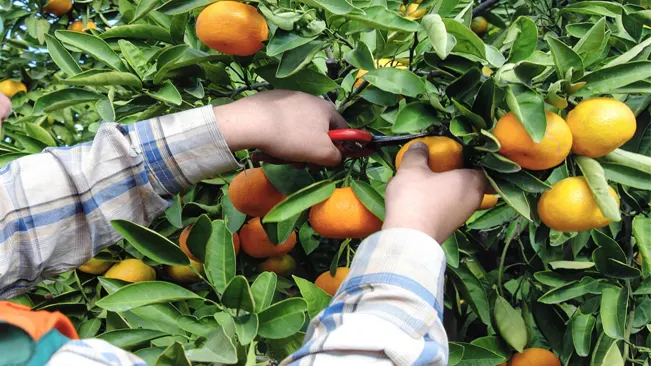
- Promotes Healthy Growth: Regular pruning helps maintain the overall health of the mandarin tree. By removing dead, diseased, or damaged branches, you reduce the risk of pests and diseases and allow the tree to focus its energy on producing healthy growth and fruit.
- Improves Fruit Quality: Pruning helps in regulating the amount of fruit the tree produces. Thinning out some of the fruit-bearing branches can lead to larger and better-quality fruits on the remaining branches, as the tree can allocate more resources to fewer fruits.
- Enhances Sunlight and Air Circulation: Proper pruning ensures that sunlight and air can penetrate the canopy of the tree. This exposure is vital for the development of fruit and helps prevent the onset of fungal diseases, which thrive in damp, shaded conditions.
- Shapes the Tree: Pruning allows you to control the shape and size of your mandarin tree, making it easier to harvest the fruits and maintain the tree. It’s especially important for trees grown in smaller spaces or containers, as it keeps their growth in check.
- Encourages New Growth: Strategic pruning stimulates new growth in mandarin trees. By cutting back certain branches, you can encourage the tree to produce new, healthy shoots. This is particularly beneficial after the tree has finished fruiting, as it prepares the tree for the next growing season.
Harvesting
Mandarins are typically ready to harvest in late fall to winter. The fruit should be fully colored and slightly soft to the touch. Gently twist the fruit to remove it from the tree.
Timing of Harvest
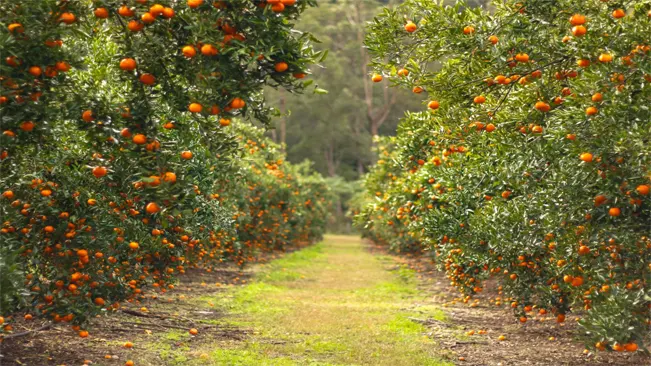
- The exact timing for harvesting mandarins can vary depending on the variety and local climate conditions. As a general rule, they are ready in late fall to winter. It’s essential to observe the color and feel of the fruit; they should have a uniform color (usually a deep orange) and a slightly soft texture. The skin should no longer feel completely firm to the touch.
Judging Ripeness
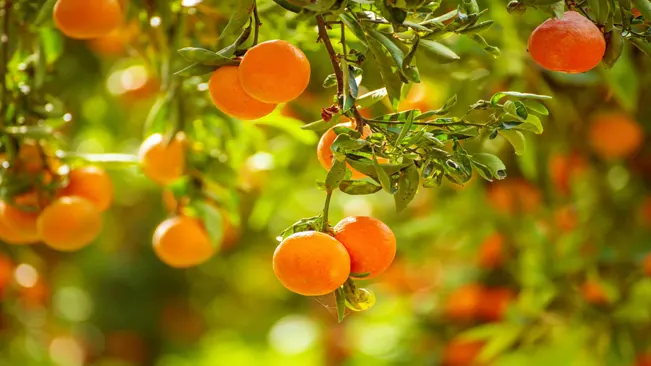
- Unlike some fruits, mandarins don’t continue to ripen significantly once picked. Therefore, determining the right time to harvest is crucial. You might want to taste a few fruits before harvesting en masse. The flavor should be sweet and fully developed.
Method of Harvesting
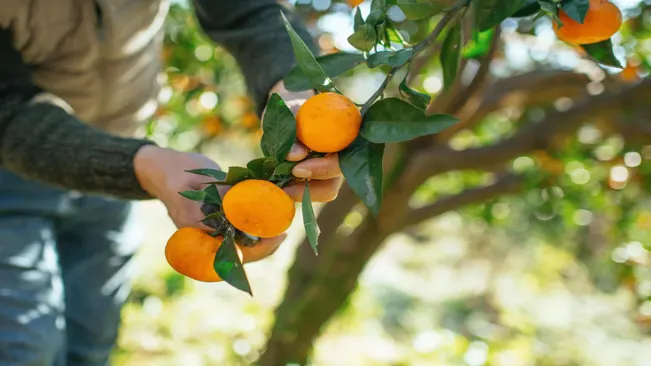
- When picking mandarins, use a gentle twisting motion to detach the fruit from the tree. This method helps to avoid damaging the fruit or the tree. It’s better not to pull the fruit directly, as this can cause the stem to tear the skin, potentially leading to quicker spoilage.
Handling After Harvest
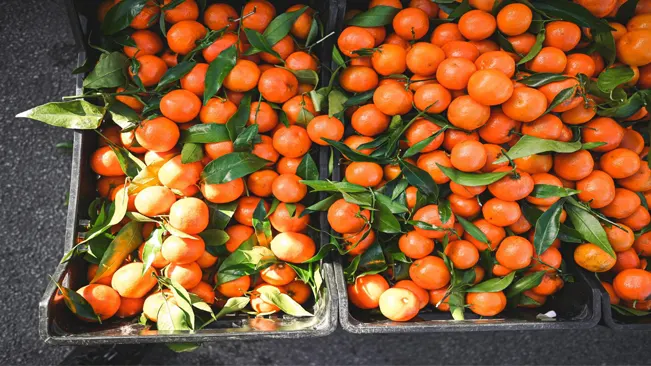
- Once harvested, handle the mandarins gently to prevent bruising. They don’t need to be refrigerated immediately but should be kept in a cool, dry place if not consumed right away.
Storage
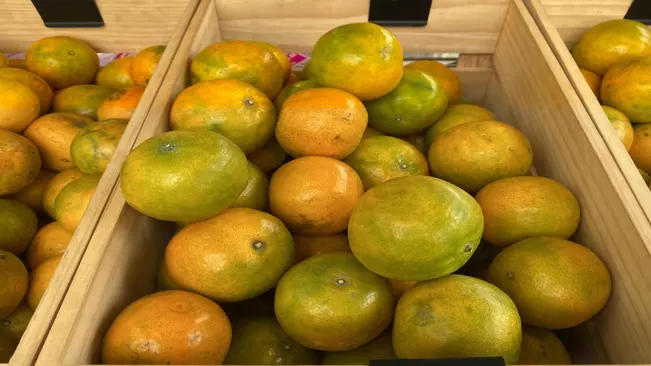
- Mandarins can be stored at room temperature for several days, making them convenient for immediate consumption. For longer storage, placing them in the refrigerator can extend their freshness for a few weeks.
Utilization

- Freshly harvested mandarins can be eaten as is, juiced, or used in various culinary preparations, from salads to desserts. Their zest also adds flavor to baked goods and sauces.
Pest and Disease Management
Pest Management
- Aphids: These small, sap-sucking insects can cause leaf curling and stunted growth. They often produce a sticky substance known as honeydew, which can lead to sooty mold. Control methods include spraying with water to dislodge them, introducing natural predators like ladybugs, or using insecticidal soaps.
- Mites: Spider mites can cause leaf discoloration and drop. They thrive in dusty, hot conditions, so keeping the area around the tree clean and well-watered can prevent infestations. Miticides or horticultural oils can be effective treatments.
- Citrus Leaf Miners: These larvae tunnel through leaves, causing silvery trails. They primarily affect young foliage. Cultural controls like removing affected leaves and maintaining tree health are primary strategies. For severe infestations, specific insecticides targeting leaf miners can be used.
Disease Management
- Citrus Canker: This bacterial disease causes lesions on leaves, stems, and fruit, leading to premature fruit drop and blemished fruit. It’s spread by rain and wind. Control measures include using copper-based fungicides and practicing good sanitation, such as disinfecting pruning tools and avoiding working with wet trees.
- Citrus Greening (Huanglongbing or HLB): This is a serious and incurable disease spread by the Asian citrus psyllid. It causes mottled leaves, stunted growth, and misshapen, bitter fruit. Managing citrus greening involves controlling the psyllid population through insecticides and removing and destroying infected trees to prevent spread.
Conclusion
Planting mandarins successfully requires choosing the right variety for your climate, ensuring they receive ample sunlight, and planting them in well-draining soil. Regular watering, fertilization, and pruning are key to healthy growth and abundant fruit production. With proper care, mandarins can be a delightful and fruitful addition to any garden, offering both aesthetic appeal and delicious, home-grown citrus.
FAQs (Frequently Asked Questions)
- What is the best time to plant mandarin trees?
- The best time to plant mandarin trees is either in the spring or fall, when the weather is mild and there’s less stress on the plants.
- The best time to plant mandarin trees is either in the spring or fall, when the weather is mild and there’s less stress on the plants.
- How much sunlight do mandarin trees need?
- Mandarin trees require full sunlight, ideally 6-8 hours per day, for optimal growth and fruit production.
- Mandarin trees require full sunlight, ideally 6-8 hours per day, for optimal growth and fruit production.
- What type of soil is suitable for mandarin trees?
- They thrive in well-draining, slightly acidic to neutral soil. Amend poor soil with compost to improve its quality.
- They thrive in well-draining, slightly acidic to neutral soil. Amend poor soil with compost to improve its quality.
- How often should I water my mandarin tree?
- Water young trees regularly to maintain evenly moist soil. Mature trees can be watered less frequently, but it’s important to avoid letting the soil dry out completely.
- Water young trees regularly to maintain evenly moist soil. Mature trees can be watered less frequently, but it’s important to avoid letting the soil dry out completely.
- Do mandarin trees need fertilization?
- Yes, they benefit from regular fertilization with a balanced citrus-specific fertilizer, especially during the growing season.
- Yes, they benefit from regular fertilization with a balanced citrus-specific fertilizer, especially during the growing season.
- How do I prune a mandarin tree?
- Prune to remove dead or diseased branches, thin out dense areas to improve air circulation, and shape the tree for better sunlight exposure.
- Prune to remove dead or diseased branches, thin out dense areas to improve air circulation, and shape the tree for better sunlight exposure.
- Can mandarin trees be grown in pots?
- Yes, mandarins can be grown in large pots or containers, provided they have adequate drainage and are watered and fertilized appropriately.
- Yes, mandarins can be grown in large pots or containers, provided they have adequate drainage and are watered and fertilized appropriately.
- What are common pests and diseases affecting mandarin trees?
- Common issues include citrus leaf miners, aphids, and diseases like citrus canker and greening. Regular monitoring and appropriate treatments are crucial.
- Common issues include citrus leaf miners, aphids, and diseases like citrus canker and greening. Regular monitoring and appropriate treatments are crucial.
- When are mandarins ready to harvest?
- Mandarins are typically ready to harvest in late fall or winter when the fruit is fully colored and slightly soft to the touch.
- Mandarins are typically ready to harvest in late fall or winter when the fruit is fully colored and slightly soft to the touch.
- Can mandarin trees withstand cold temperatures?
- Mandarin trees can tolerate some cold, but they are sensitive to frost. Protection or moving potted trees indoors is necessary in colder climates.

Kristine Moore
Forestry AuthorI'm Kristine Moore, a seasoned garden landscaping professional with over 30 years of experience. My extensive career has been dedicated to transforming outdoor spaces into stunning, sustainable landscapes. With a deep understanding of horticulture, design principles, and environmental stewardship, I have become a respected figure in the field, known for creating harmonious, visually appealing, and eco-friendly gardens. My commitment to excellence and continuous learning in landscaping trends and techniques has solidified my reputation as an expert in garden design and implementation.













Leave your comment